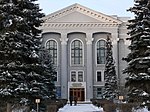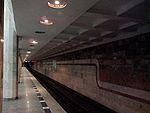Verkin Institute for Low Temperature Physics and Engineering

The B. Verkin Institute for Low Temperature Physics and Engineering is a research institute that conducts basic research in experimental and theoretical physics, mathematics, as well as in the field of applied physics. It was founded in 1960 by Borys Verkin, Oleksandr Galkin, Borys. Eselson and Ihor Dmytrenko. The first director was Borys Verkin. Main areas of research are high-temperature superconductivity, weak superconductivity, magneto antiferromagnets, physics of low-dimensional systems, point-contact spectroscopy, quantum crystals, nonlinear phenomena in metals, physics of disordered systems, quantum phenomena in plasticity and others. The institute has published about 250 monographs, textbooks, reference books, more than 12,000 articles and reviews in ranking scientific journals, and has trained more than 850 highly qualified experts — PhDs.
Excerpt from the Wikipedia article Verkin Institute for Low Temperature Physics and Engineering (License: CC BY-SA 3.0, Authors, Images).Verkin Institute for Low Temperature Physics and Engineering
Науки проспект, Kharkiv Pavlove Pole
Geographical coordinates (GPS) Address Phone number Website Nearby Places Show on map
Geographical coordinates (GPS)
| Latitude | Longitude |
|---|---|
| N 50.039636 ° | E 36.220159 ° |
Address
Фізико-технічний інститут низьких температур
Науки проспект
61101 Kharkiv, Pavlove Pole
Kharkiv Oblast, Ukraine
Open on Google Maps








